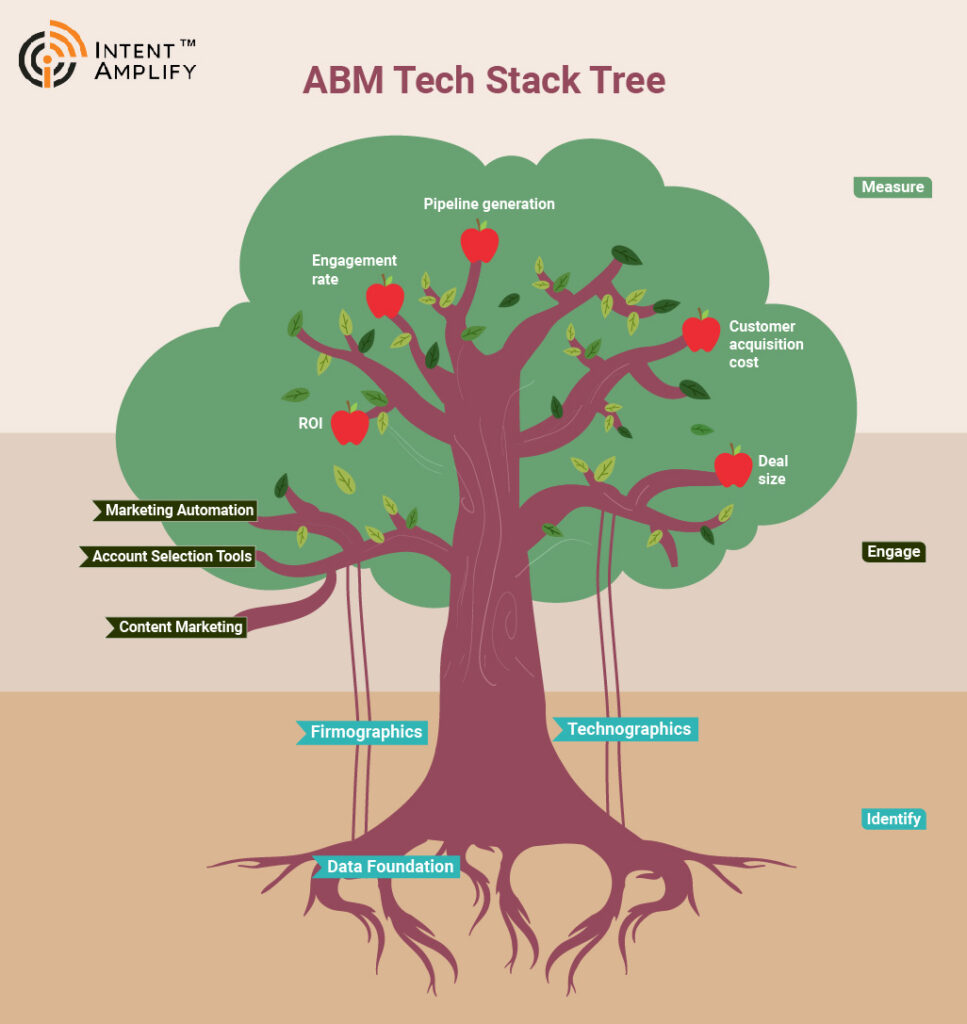
How to Build Your ABM Tech Stack: The Right Tools for Success
Account-Based Marketing (ABM) is all about focusing your efforts on a defined set of high-value accounts. But with such a targeted approach, you need the right technology stack to turn strategy into success. This article will guide you through the essential tools you need to build a winning ABM tech stack.
What is a Tech Stack?
A Tech stack is nothing but a collection of technologies such as tools, frameworks, databases, and APIs that you may require to effectively execute some task.
Building the Foundation: Identify, Engage, Measure
The success of your ABM strategy hinges on three core pillars:
- Identifying the right targets,
- Engaging them with precision, and
- Measuring the impact of your efforts.
You need to build an ABM tech stack that covers these functions. Here’s a deeper dive into each:
1. Identifying the right targets:
Building a successful ABM tech stack begins with the crucial step of identifying and prioritizing target accounts. In ABM, we laser-focus on high-value accounts with the greatest potential to become loyal customers. But how do you identify these ideal accounts? This is where data becomes your weapon. There are two types of data you can consider:
- Firmographics: Unveil the “Who” – firmographic data dives deep into a company’s characteristics, encompassing industry, size, location, and growth rate. This intel helps you tailor your approach to resonate with their specific needs and challenges.
- Technographics: Understand the “How” – technographic data sheds light on the technologies a company uses. This includes their existing software stack, website technologies, and data usage patterns. By understanding “how” they operate, you can identify potential gaps your solution can address.
Account Selection Tools: Making the Data Work for You
Account selection tools act as powerful engines, crunching vast amounts of firmographic and technographic data. Leveraging firmographic and technographic data, these tools allow you to build targeted account lists that perfectly align with your ideal customer profile (ICP).
- Scoring and Prioritization: Account selection tools go beyond simple list building. They assign scores to accounts based on their fit and potential value, allowing you to prioritize your outreach efforts and focus on the most promising leads.
- Identifying Buying Committees: These tools can pinpoint key decision-makers within your target accounts. This ensures your outreach reaches the right people who can champion your solution within their organization.
2. Engage with precision:
Once you’ve identified your ideal accounts, it’s time to craft personalized experiences that resonate. Marketing automation platforms are your ABM tech stack weapons here.
- Segmentation Capabilities: These platforms allow you to segment your target accounts based on firmographic and technographic data, as well as website behavior and engagement with past marketing efforts. This segmentation ensures your messaging is hyper-relevant to each account’s specific needs and interests.
- Targeted Outreach Features: Move beyond generic emails and social media blasts. Marketing automation allows you to personalize outreach across various channels. This includes crafting targeted email campaigns, personalized landing pages, and dynamic website content that adapts to each account.
- Omnichannel Engagement: ABM thrives on a multi-channel approach. Marketing automation helps you orchestrate seamless campaigns across various channels like email, social media, display advertising, and direct mail. This ensures consistent messaging and a unified brand experience for your target accounts.
Some marketing Automation platforms: Hubspot, Eloqua, Marketo, Mailchimp, and Pardot.
3. Measure for impact:
Data is king, not just in identifying targets, but also in measuring the success of your ABM efforts. Here’s how to ensure your efforts translate to real business value:
- Leverage CRM Data: Track account interactions within your CRM system. This includes email opens, website visits, and engagement with marketing content. By monitoring this data, you can gauge account interest and identify opportunities to nurture leads further.
- Website Analytics: Go beyond vanity metrics like website traffic. Use website analytics tools to track specific actions taken by your target accounts on your website. This might include downloading whitepapers, registering for webinars, or requesting demos. These actions indicate a deeper level of engagement and buying intent.
- Engagement Metrics from ABM Tools: Many ABM platforms offer built-in analytics dashboards. These dashboards track key metrics like engagement rates, click-through rates, and form submissions specifically tied to your ABM campaigns. Analyzing this data helps you understand what resonates with your target accounts and allows you to optimize campaigns for better results.
- Measure ROI: The ultimate goal of any marketing effort is to drive revenue. Track the impact of your ABM efforts on key metrics like pipeline generation, deal size, and customer acquisition cost. This allows you to demonstrate the tangible value of ABM to your organization and secure continued investment in your strategy.
By mastering these three core elements – identifying the right targets, engaging them with precision, and measuring the impact – you can build a solid foundation for successful ABM campaigns that deliver real results.

Personalization and Collaboration for ABM Success
While identifying targets, engaging precisely, and measuring impact are crucial, ABM goes beyond the basics. To truly elevate your campaigns, consider these two additional elements:
1. Personalize the Journey: Make Each Interaction Count
In today’s digital landscape, generic marketing messages fall flat. In ABM, personalization is key to building meaningful relationships with your target accounts. Here’s how to take personalization to the next level:
- Website Personalization Tools: These tools leverage data about your target accounts (firmographics, techno graphics, website behavior) to dynamically tailor the content and experience they see on your website. Imagine a high-growth tech company visiting your website. Website personalization tools can automatically display case studies highlighting your success with similar companies and showcase features that address their specific industry challenges. This level of personalization grabs attention and demonstrates a deep understanding of their needs.
- Account-Based Content Marketing: Move beyond generic blog posts and whitepapers. Craft targeted content assets specifically tailored to the interests and challenges of your high-value accounts. This might include industry-specific whitepapers, custom case studies showcasing success with similar companies, or personalized webinars addressing their unique pain points.
- Dynamic Calls to Action (CTAs): Don’t settle for generic “Contact Us” CTAs. Personalize your CTAs based on the account’s stage in the buyer’s journey. For accounts in the early awareness stage, a CTA offering a free industry report might be most relevant. For later-stage accounts, a CTA to schedule a personalized demo showcasing your solution’s specific value proposition would be more appropriate.
By personalizing the website experience, content marketing efforts, and CTAs, you create a one-to-one feel that resonates with your target accounts and positions your company as a true partner in their success.
2. Align Sales and Marketing: Ensure Everyone’s on the Same Page
Effective ABM requires seamless collaboration between sales and marketing teams. Here’s how to break down silos and ensure everyone’s working towards the same goal:
- Sales Enablement Tools: Equip your sales reps with the targeted insights and resources they need to engage effectively with high-value accounts. These tools might include battle cards with key talking points specific to each account, competitor comparisons tailored to their industry, and social selling tools to connect with key decision-makers on platforms like LinkedIn.
- Collaboration Platforms: Break down communication barriers with platforms that foster real-time communication and information sharing between sales and marketing teams. This allows for joint planning of outreach strategies, and sharing of account engagement data, and ensures everyone has a clear view of the progress made with each target account.
- Service Level Agreements (SLAs): Establish clear agreements between sales and marketing regarding lead qualification, response times, and communication protocols for ABM campaigns. This ensures both teams are aligned on expectations and fosters a collaborative environment that drives success.
By personalizing the customer journey and fostering strong sales and marketing alignment, you can create a powerful ABM strategy that resonates with your target accounts, builds lasting relationships, and ultimately drives significant business growth.
Remember: It’s All About You
The beauty of ABM lies in its targeted approach. There’s no magic bullet, and the perfect ABM tech stack will vary depending on your unique needs and goals. Here are some key considerations to keep in mind as you build your custom stack:
Align with Your ABM Strategy:
Before diving into specific tools, take a step back and revisit your overall ABM strategy. What are your specific goals? Are you focusing on acquiring new logos or expanding relationships with existing high-value accounts? Understanding your objectives will guide your ABM tech stack selection.
Prioritize Integrations:
Data is the lifeblood of ABM. Ensure seamless data flow between your ABM tools and your existing CRM, marketing automation, and analytics platforms. This eliminates data silos and ensures a unified view of your target accounts across all touchpoints. Tools with robust API integrations or pre-built connectors will save you time and effort.
Focus on Ease of Use:
A user-friendly tech stack empowers your team to execute your ABM strategy efficiently. Don’t get bogged down by overly complex tools with cumbersome interfaces. Choose solutions that are intuitive and easy for your marketing and sales teams to adopt and leverage.
Start Small and Scale Up:
Building a robust ABM tech stack takes time. Don’t feel pressured to acquire every available tool at once. Start with a core set of essential solutions that address your immediate needs and then scale up as your ABM program matures.
Measure the ROI:
Every element of your ABM strategy, including your tech stack, should be measurable. Track the impact of your ABM efforts on key metrics like pipeline generation, deal size, and customer acquisition cost. This data will help you identify which tools are driving results and allow you to optimize your tech stack for maximum return on investment.
Conclusion
By keeping these factors in mind, you can build a custom ABM tech stack that perfectly aligns with your strategic goals, empowers your teams, and delivers measurable success. Remember, the most important aspect is choosing tools that facilitate strategic targeting, personalized engagement, and ultimately, drive significant business growth for your organization.




